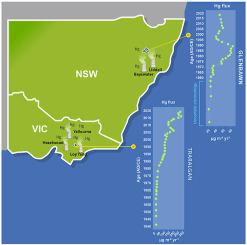当前位置:
X-MOL 学术
›
Environ. Pollut.
›
论文详情
Our official English website, www.x-mol.net, welcomes your feedback! (Note: you will need to create a separate account there.)
Mercury atmospheric emission, deposition and isotopic fingerprinting from major coal-fired power plants in Australia: Insights from palaeo-environmental analysis from sediment cores
Environmental Pollution ( IF 8.9 ) Pub Date : 2021-06-16 , DOI: 10.1016/j.envpol.2021.117596 Larissa Schneider 1 , Neil L Rose 2 , Lauri Myllyvirta 3 , Simon Haberle 1 , Anna Lintern 4 , Jingjing Yuan 5 , Darren Sinclair 6 , Cameron Holley 7 , Atun Zawadzki 8 , Ruoyu Sun 5
Environmental Pollution ( IF 8.9 ) Pub Date : 2021-06-16 , DOI: 10.1016/j.envpol.2021.117596 Larissa Schneider 1 , Neil L Rose 2 , Lauri Myllyvirta 3 , Simon Haberle 1 , Anna Lintern 4 , Jingjing Yuan 5 , Darren Sinclair 6 , Cameron Holley 7 , Atun Zawadzki 8 , Ruoyu Sun 5
Affiliation

|
Despite Australia's high reliance on coal for electricity generation, no study has addressed the extent to which mercury (Hg) deposition has increased since the commissioning of coal-fired power plants. We present stratigraphic data from lake sediments in the Hunter Valley (New South Wales) and Latrobe Valley (Victoria), where a significant proportion of Australia's electricity is generated via coal combustion. Mercury deposition in lake sediments increased in the 1970s with the commissioning of coal-fired power plants, by a factor of 2.9-times in sediments of Lake Glenbawn (Hunter Valley) and 14-times in Traralgon Reservoir (Latrobe Valley). Sediments deposited after the commissioning of power plants have distinct Hg isotope compositions, similar to those of combusted coals. Mercury emission, estimated using an atmospheric model (CALPUFF), was higher in the Latrobe Valley than in the Hunter Valley. This is a result of higher Hg concentrations in lignite coal, lax regulation and older pollution-control technologies adopted by coal-fired power plants in the Latrobe Valley. Near-source deposition of Hg in Australia is significantly higher than North America and Europe, where better emission controls (e.g. wet flue gas desulfurization) have been in effect for decades. The challenge for Australia in years to come will be to ratify the Minamata Convention and develop better regulation policies to reduce Hg emissions.
中文翻译:

澳大利亚主要燃煤发电厂的汞大气排放、沉积和同位素指纹图谱:沉积物岩心古环境分析的见解
尽管澳大利亚高度依赖煤炭发电,但尚无研究探讨自燃煤电厂投入运行以来汞 (Hg) 沉积增加的程度。我们提供了猎人谷(新南威尔士州)和拉特罗布谷(维多利亚州)湖泊沉积物的地层数据,澳大利亚很大一部分电力是通过煤炭燃烧产生的。 20 世纪 70 年代,随着燃煤发电厂的投产,湖泊沉积物中的汞沉积量有所增加,格伦鲍恩湖(猎人谷)沉积物中的汞沉积量增加了 2.9 倍,特拉拉尔贡水库(拉特罗布山谷)沉积物中的汞沉积量增加了 14 倍。发电厂投入运行后沉积的沉积物具有独特的汞同位素成分,与燃煤的成分相似。使用大气模型 (CALPUFF) 估算的拉特罗布谷的汞排放量高于猎人谷。这是由于褐煤中汞浓度较高、监管不严以及拉特罗布山谷燃煤电厂采用的污染控制技术较旧造成的。澳大利亚的汞近源沉积明显高于北美和欧洲,而北美和欧洲几十年来一直实行更好的排放控制(例如湿法烟气脱硫)。澳大利亚未来几年面临的挑战将是批准《水俣公约》并制定更好的监管政策以减少汞排放。
更新日期:2021-06-16
中文翻译:

澳大利亚主要燃煤发电厂的汞大气排放、沉积和同位素指纹图谱:沉积物岩心古环境分析的见解
尽管澳大利亚高度依赖煤炭发电,但尚无研究探讨自燃煤电厂投入运行以来汞 (Hg) 沉积增加的程度。我们提供了猎人谷(新南威尔士州)和拉特罗布谷(维多利亚州)湖泊沉积物的地层数据,澳大利亚很大一部分电力是通过煤炭燃烧产生的。 20 世纪 70 年代,随着燃煤发电厂的投产,湖泊沉积物中的汞沉积量有所增加,格伦鲍恩湖(猎人谷)沉积物中的汞沉积量增加了 2.9 倍,特拉拉尔贡水库(拉特罗布山谷)沉积物中的汞沉积量增加了 14 倍。发电厂投入运行后沉积的沉积物具有独特的汞同位素成分,与燃煤的成分相似。使用大气模型 (CALPUFF) 估算的拉特罗布谷的汞排放量高于猎人谷。这是由于褐煤中汞浓度较高、监管不严以及拉特罗布山谷燃煤电厂采用的污染控制技术较旧造成的。澳大利亚的汞近源沉积明显高于北美和欧洲,而北美和欧洲几十年来一直实行更好的排放控制(例如湿法烟气脱硫)。澳大利亚未来几年面临的挑战将是批准《水俣公约》并制定更好的监管政策以减少汞排放。



























 京公网安备 11010802027423号
京公网安备 11010802027423号